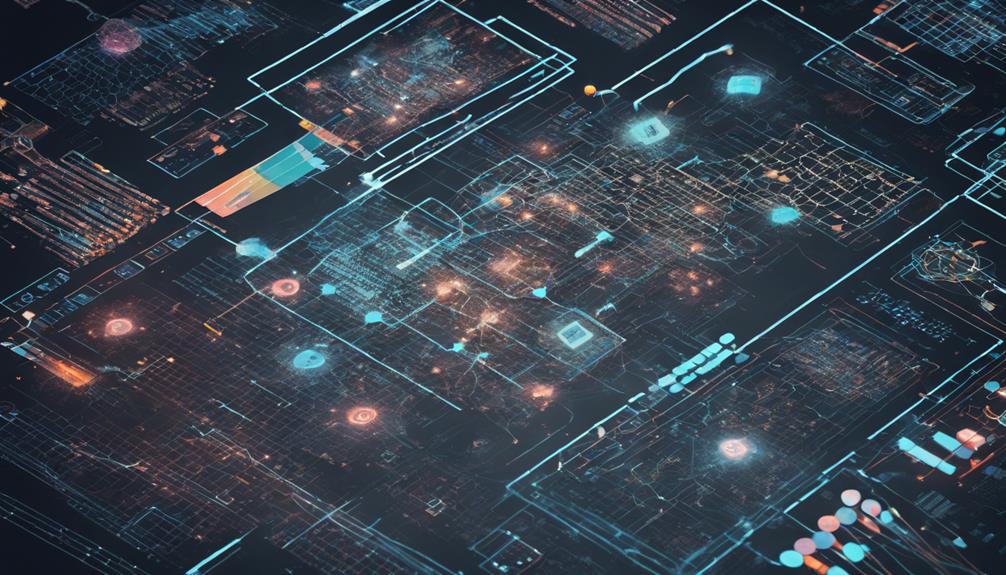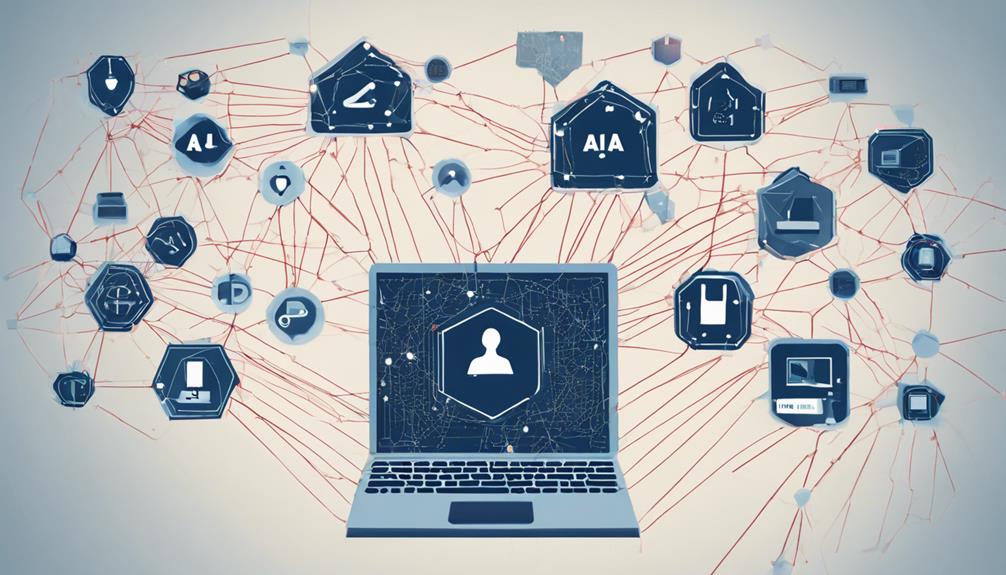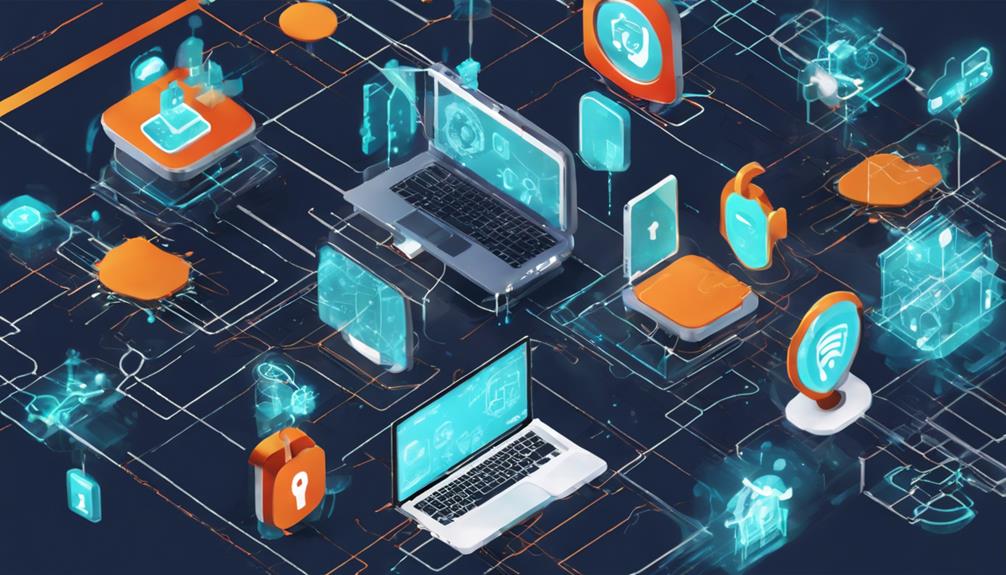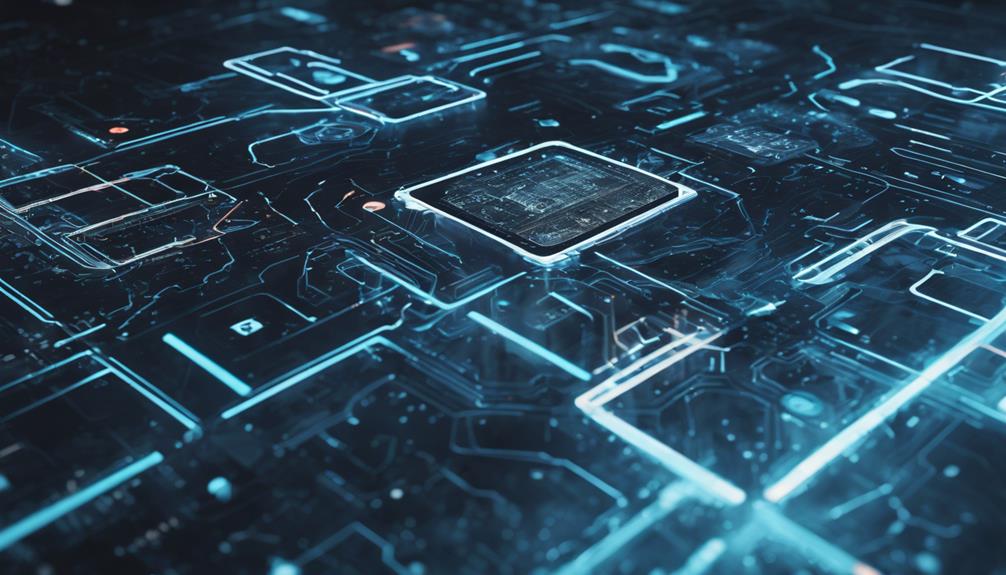AI is reshaping cybersecurity with versatile tools for protection. It enhances threat detection with real-time alerts and pattern analysis, boosting incident response speeds. By monitoring user behavior, it swiftly identifies anomalies and reduces false alarms. AI's malware detection success rates reach up to 92%, using advanced algorithms for accurate analysis. Endpoint security benefits from real-time anomaly detection and robust encryption like AES and SHA. Insider threat detection is improved through AI-driven user behavior analysis. Embrace AI in cybersecurity for all-encompassing protection against evolving cyber threats and efficient incident response. Discover more about AI's practical applications in safeguarding digital environments.
Key Takeaways
- AI strengthens threat detection with real-time log analysis and proactive responses.
- Automated forensic analysis enhances incident response times.
- AI-powered systems achieve malware detection rates of 80% to 92%.
- User behavior monitoring with AI reduces false positives in threat alerts.
- Advanced encryption algorithms like AES and SHA ensure data protection.
AI in Threat Detection
The integration of AI in threat detection has greatly strengthened cybersecurity measures, achieving impressive security rates in malware detection and enhancing incident response capabilities. By utilizing machine learning algorithms, AI can analyze real-time log data to detect patterns and anomalies, enabling organizations to identify potential security breaches swiftly.
Additionally, AI triggers real-time alerts and notifications for security teams, automating incident response actions such as isolating affected systems, thereby reducing response times considerably.
One of the key strengths of AI in threat detection lies in its ability to detect insider threats through user behavior analysis. This empowers organizations to proactively respond to security breaches caused by malicious internal actors.
Furthermore, AI plays an important role in analyzing email content, accurately classifying emails into categories such as spam, phishing, and legitimate messages. This level of accuracy, around 94%, ensures enhanced cybersecurity by filtering out potentially harmful emails before they can cause any damage.
Data Analysis for Incident Response

Data analysis plays a vital role in incident response within cybersecurity operations. Real-time threat detection allows for the immediate identification of anomalies and potential security breaches.
Automated forensic analysis and predictive threat modeling further enhance response times and accuracy in addressing cyber threats.
Real-Time Threat Detection
Utilizing advanced artificial intelligence technologies, real-time threat detection in cybersecurity involves analyzing extensive datasets to swiftly identify potential security incidents. By employing machine learning algorithms, cybersecurity systems can achieve impressive detection rates ranging from 80% to 92% for detecting malware activities, enhancing the overall security posture.
These AI systems excel at analyzing user behavior patterns to promptly detect anomalies and potential breaches, enabling proactive responses to mitigate risks effectively. Additionally, the automated incident response capabilities of AI empower systems to take immediate actions, such as isolating affected endpoints, in response to identified threats in real-time.
Furthermore, artificial intelligence plays a vital role in email security by accurately distinguishing between spam, phishing attempts, and legitimate emails, significantly reducing the likelihood of falling victim to cyber threats. The continuous evolution of AI in cybersecurity is instrumental in fortifying defenses against a wide array of cyber threats, highlighting its pivotal role in safeguarding digital assets.
Automated Forensic Analysis
By harnessing the power of artificial intelligence, automated forensic analysis in cybersecurity revolutionizes incident response through rapid processing of extensive data sets. AI algorithms play an essential role in analyzing digital evidence swiftly to pinpoint the source and impact of a cyber incident.
These automated forensic tools, powered by AI, excel in detecting anomalies, patterns, and indicators of compromise in real-time, enabling organizations to respond promptly to security incidents. Furthermore, AI-driven forensic analysis automates data analysis tasks, leading to faster investigations with enhanced efficiency and accuracy.
Leveraging AI in cybersecurity not only streamlines the investigative process but also improves the overall effectiveness of incident response strategies. Organizations can rely on automated forensic analysis to bolster their defenses, ensuring a proactive approach to cybersecurity that prioritizes swift detection and mitigation of threats.
Predictive Threat Modeling
AI-driven predictive threat modeling in cybersecurity leverages historical data to forecast potential cyber threats, enhancing organizations' proactive defense strategies.
By utilizing AI algorithms to analyze patterns in data, predictive threat modeling can identify and mitigate security incidents before they materialize.
Through user behavior analysis and network traffic analysis, AI can predict and prevent cyber attacks by recognizing abnormal activities or potential vulnerabilities.
This proactive approach enables cybersecurity teams to stay ahead of emerging threats, fortifying their defenses against evolving attack vectors.
Implementing AI-driven predictive analytics not only enhances incident response capabilities but also streamlines the overall cybersecurity defense posture of an organization.
Leveraging the power of predictive threat modeling empowers security professionals to anticipate and counteract future cyber threats effectively, making it an essential component in the ongoing battle against malicious actors in the digital landscape.
User Behavior Monitoring With AI
User behavior monitoring with AI involves the use of anomaly detection algorithms, predictive threat modeling, and real-time activity analysis to protect networks.
These advanced tools enable the ongoing evaluation of user actions, facilitating the prompt detection of possible security breaches.
Anomaly Detection Algorithms
Anomaly detection algorithms leverage artificial intelligence to monitor and analyze user behavior for deviations from normal patterns, enhancing cybersecurity threat detection capabilities. Through the use of AI algorithms, organizations can bolster their security measures by actively monitoring and flagging abnormal activities that may indicate a potential security threat.
Here are three key benefits of employing anomaly detection with AI in cybersecurity defenses:
- Improved Accuracy: AI-powered anomaly detection enhances threat detection accuracy by analyzing vast amounts of data to identify suspicious behavior accurately.
- Reduced False Positives: By continuously learning and adapting, AI algorithms help in reducing false positive alerts, allowing security teams to focus on genuine threats more effectively.
- Proactive Risk Detection: Implementing anomaly detection with AI enables proactive risk detection, strengthening incident response capabilities and overall cybersecurity defenses.
Predictive Threat Modeling
Monitoring and analyzing user behavior with artificial intelligence in cybersecurity extends beyond anomaly detection to encompass predictive threat modeling. By leveraging predictive analytics and user behavior analytics, AI can identify potential security threats before they result in security breaches or cyber attacks.
AI-driven systems analyze patterns in user interactions to predict and prevent malicious activities proactively. This predictive threat modeling not only enhances incident response capabilities by detecting suspicious behaviors early but also aids in preventing security breaches effectively.
Through continuous monitoring of user behavior, AI can offer insights into potential vulnerabilities within a system, allowing organizations to take preemptive actions to safeguard their data and infrastructure. By integrating predictive threat modeling into cybersecurity strategies, businesses can stay one step ahead of cyber threats, mitigating risks and ensuring a robust security posture.
This proactive approach not only enhances overall cybersecurity resilience but also minimizes the impact of potential security incidents.
Real-Time Activity Analysis
Utilizing artificial intelligence in cybersecurity, real-time activity analysis plays a crucial role in continuously monitoring network behavior to detect deviations and potential threats promptly. AI models are instrumental in this process, as they continuously analyze network behavior, triggering proactive responses to block malicious activities.
User behavior analytics with AI has revolutionized threat detection and prevention processes, allowing businesses to identify evolving threats effectively. Additionally, AI creates application profiles that enhance threat hunting processes, improving the accuracy in spotting abnormal activities.
In practical terms, organizations like Wells Fargo leverage AI for network traffic analysis and email communications monitoring. By employing AI in real-time activity analysis, these organizations can swiftly respond to potential threats, ensuring the security of their systems and data.
This proactive approach to cybersecurity, enabled by AI technologies, empowers businesses to stay ahead of cyber threats and protect their digital assets effectively.
Malware Detection and Analysis

AI-powered systems have greatly enhanced the efficiency of malware detection, achieving success rates ranging from 80% to 92%. Machine learning algorithms play an essential role in enabling these systems to detect and analyze malicious activity effectively.
Techniques such as computer vision are utilized to enhance the accuracy of malware detection. It is alarming that in 2019, 93.67% of observed malware had the capability to modify its source, making it more challenging to detect and combat.
Ransomware attacks, which involve demanding a ransom for file or system access, pose a significant threat to cybersecurity. Additionally, phishing attacks, a prevalent form of cyber threat, use deceptive emails with malicious links to obtain sensitive information.
Endpoint Security Enhancements

Endpoint security enhancements leverage advanced technologies to establish baselines of normal device behavior for real-time anomaly detection. AI-driven protection plays an essential role in identifying and mitigating threats without the need for constant signature updates.
To fortify endpoint security effectively, organizations are adopting the following measures:
- Advanced Authentication: Implementing methods such as CAPTCHA challenges, facial recognition, and fingerprint scanners alongside traditional passwords enhances the overall security posture by adding layers of protection.
- Encryption Algorithms: Utilizing robust encryption algorithms like AES and SHA ensures that sensitive information remains secure, even against sophisticated AI-driven attacks that aim to breach data integrity.
- Zero-day Attack Detection: By monitoring behaviors and anomalies in real-time, AI-powered endpoint security solutions can swiftly identify and respond to zero-day attacks, providing proactive defense mechanisms against evolving threats.
These enhancements collectively strengthen endpoint security, safeguarding devices and data from malicious actors seeking to exploit vulnerabilities.
Encryption for Data Protection

Data protection is greatly enhanced through the utilization of robust encryption algorithms like AES and SHA. Encryption methods such as AES play a critical role in safeguarding sensitive information by converting it into secure data that is nearly impossible to decipher without the decryption key.
This guarantees the confidentiality of data and prevents unauthorized access to sensitive information. Strong encryption algorithms like RSA and ECC are designed to be highly secure, making it challenging for attackers and AI to break the encryption and access the encrypted data.
AI for Insider Threat Detection

Utilizing advanced artificial intelligence technologies, organizations bolster their cybersecurity defenses by leveraging AI for the detection of insider threats. AI analyzes user behavior across systems to detect anomalies and potential insider threats effectively. AI models continuously monitor network behavior, self-correct, and adapt for improved accuracy in threat detection, ensuring a proactive approach to cybersecurity.
Additionally, using AI, organizations like Wells Fargo automate responses to cyber threats from various vectors, enhancing incident response times greatly. This automation streamlines the process of identifying and mitigating insider threats promptly.
Furthermore, AI in cybersecurity triggers proactive measures based on network traffic and email communication analysis, blocking malicious activities before they can cause harm. By revolutionizing threat detection and prevention, AI assists in identifying evolving threats and vulnerabilities effectively, making it an invaluable asset in safeguarding sensitive information and maintaining a secure digital environment.
Frequently Asked Questions
What Is the Application of AI in Cyber Security?
AI applications in cybersecurity encompass threat detection, incident response enhancement, and predictive analysis. Machine learning algorithms classify artifacts, detect anomalies, and prioritize vulnerabilities for proactive defense. AI optimizes network security operations, reduces workload, and enhances accuracy.
How Does AI Protect Security?
AI safeguards security by leveraging advanced algorithms to analyze data for threat detection. Through automation, AI enhances incident response, improves threat detection accuracy, identifies insider risks, and predicts cyber attacks. These capabilities fortify defenses and bolster overall cybersecurity resilience.
Which of the Following Is an AI Technique Commonly Used in Cybersecurity?
In the field of cybersecurity, anomaly detection stands out as a powerful AI technique. By scrutinizing data for irregularities and deviations from the norm, anomaly detection helps identify potential threats and abnormal activities, fortifying security defenses effectively.
How Is AI Used in Cyber Crime?
AI is utilized in cybercrime to create sophisticated malware, personalize phishing attacks, automate social engineering tactics, deploy bots for large-scale attacks like DDoS, and scan data for vulnerabilities. Hackers leverage AI to adapt and evolve malicious strategies.
Conclusion
To sum up, the use of AI in cybersecurity offers a powerful and effective means of protection against threats. By utilizing advanced technologies such as threat detection, data analysis, user behavior monitoring, malware detection, endpoint security, encryption, and insider threat detection, organizations can greatly enhance their security measures.
Embracing AI in cybersecurity is not just a beneficial option, but a necessary step in safeguarding valuable data and information in today's digital landscape.









